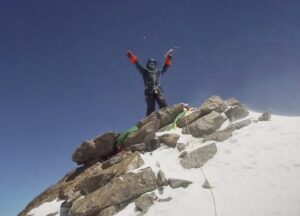In July, a quiet European team headed for one of the hidden valleys of Ladakh, in northern India. Still relatively wild and lonely, the area offers plenty of potential for exploration, first ascents, and new routes. Patrick Tirler and Moritz Sigmund opened one of these on the smooth granite spires of 5,800m Jamyang Ri.

Ladakh is tucked between Pakistan, Afghanistan, China/Tibet, and the northern Indian states of Jammu & Kashmir and Himachal Pradesh. Map by Mapsofindia.com
Tirler described the 700m line, done in an 18-hour push on July 21, as the most beautiful route he has ever climbed and his proudest achievement. That’s a lot to say for someone who grew up in the Italian Dolomites.

Jamyang Ri’s upper sections were sharp as crystal. Photo: Patrick Tirler
A crystal tower
The new route highlighted a three-week expedition in Rangtik Topko, a side valley of Zanskar. The smooth granite faces of Jamyang Ri rose right behind their tents and are also visible from the road from Padur, the closest village.
“The peak resembles a rock crystal, with smooth sides and clearly visible edges that mark the change in light/shadow at different times of the day,” they wrote in their detailed report on Tirler’s website. “One of these striking edges pointed directly into the valley and attracted our attention every morning as soon as we crawled out of the tents.”
Of course, they went for it.
The first attempt to climb the central part of the northwest face to a fore summit failed after six pitches and three days of intense work.
“[Then] we decided on the gully between the main and secondary summits, and goes down to the base of the wall,” they wrote.
They left at 4 am, carrying minimal gear. Seven hours and 10 pitches later — they shared the four first pitches with a previous Slovenian route — they reached the top of the gully. Here, the real work began. They had no clue whether a climbable line ran from there to the summit.

Jamyang Ri, with the foresummit right in front of the main peak. Photo: Patrick Tirler
The first pitch took us directly to the edge of the “rock crystal” and into a crack that we could already see from base camp. Never in our best dreams could we have imagined that this crack would turn out to be one of the most beautiful alpine cracks we have ever climbed. We enjoyed this happiness for two whole pitches.

The most enjoyable part of the climb was right after the gully. Photo: Patrick Tirler
Sharp angles, few features
As the crack ended, the climbers had to find a way across the smooth face. They tried traversing left and right and risked a pendulum fall on highly difficult terrain. Eventually, they continued up a thin crack, then dodged a roof by a short rappel to another little crack. Finally, they made the last meters to the summit.
As far as the climbers know, they are the third team to reach that summit. Don’t miss the entire report and images on Tirler’s website.

Finally, the summit. Photo: Patrick Tirler
The climbers used no bolts on the way up. They did, however, hand-drill a bolt when they got lost on the descent. They had tried to follow the details provided by the 2017 Slovenian team but found themselves in the middle of the face, at the end of their rope with nothing but smooth rock around. It was impossible to manage a belay station there with only the natural rock features. They reached base camp 18 hours after departure, exhausted but happy.

The climbers. Photo: Patrick Tirler







